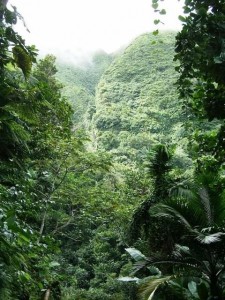Basseterre, St. Kitts, November 07, 2014 (SKNIS): St. Kitts and Nevis will be better able to manage Climate Change and Sustainable Land Management (SLM) due to assistance from the Organization of Eastern Caribbean States (OECS) Mission and the European Union (EU).
Through the Global Climate Change Alliance (GCCA) project on Climate Change Adaptation (CCA) and SLM, the Ministry of Environment and Sustainable Development will execute intervention programs at the Central Forest Reserve in St. Kitts and the New River Coconut Walk in Nevis.

Senior Environmental Office, at Sustainable Development June Hughes, explained what the GCCA is as it relates to climate change.
“Global Climate Change Alliance is a pool of funds set aside by the EU for the management and implementation of climate change, the world over,” explained Ms. Hughes. “The CCA and SLM Project are intended to support the efforts of the OECS to help member states improve their resilience to the impacts of climate change.”
A representative from the University of the West Indies (UWI) Engineering Institute Eleanor Jones pointed out why focus is placed on CCA and SLM.
Director of Physical Planning and Environment (PPE) in the Ministry of Sustainable Development, Randolph Edmead expressed that Sustainable Land Management is of extreme importance to St. Kitts and Nevis.
“Over the years, St. Kitts in particular was involved in sugar cane production and the sugar cane provided a natural cover for the soil which protected the soil from erosion,” he said. “Since the termination of sugar cane production a lot of the soil is now exposed to the elements of weather.
“We (St. Kitts and Nevis) are seeing increased rate of erosion. If left untouched, we run the risk of losing a lot of our soil and we have to always keep in mind that land soil is finite. SLM is geared at all the interventions that can be put in place to ensure the soil will last as long as possible and that it is sustainably managed and remains productive.”
The Director of PPE mentioned ways in which citizens can contribute to SLM and stated that they should think about the importance of plants before destroying them.
“Before you go and clean an area completely for cultivation, think about the consequence,” he said. “[Rather than] cleaning an area completely, you may want to clean the area where you want to plant.
“Development on hillsides is very tricky. One has to ensure that it is done in a way so as to not increase the rate of soil erosion or mass movement. It is very convenient to set fire to vegetation for cleaning, but fire is an indiscriminate tool so it will destroy everything.”
He further mentioned that “rather than using fire” they should “think about cleaning the shrubbery and allow the vegetative matter to remain there and decompose and this will add nutrients to the soil and help keep it in tact.”
An approximate €5 million Euros or EC$16.75 million was made available for this project and it is expected to be completed by 2018.
